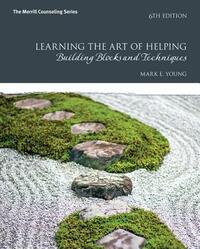Take a photo of a barcode or cover
5 reviews for:
Learning the Art of Helping: Building Blocks and Techniques with eText & MyCounselingLab Code
Mark E. Young
5 reviews for:
Learning the Art of Helping: Building Blocks and Techniques with eText & MyCounselingLab Code
Mark E. Young
This was a class read. I am definitely purchasing this book once I graduate.
Three and a half. Definitely could use an update In terms of PC culture, GI/SO language and an overhaul in the level of condescension and patronization present. I mean, if we’re being trained in a profession where the crux of it is to validate someone’s lived experience, wouldn’t you do everything in your power to ensure that was the case? Anything less or else is just false advertising plain and simple. The writing was good and clear. But yea, especially since I took a skill based class where this was the textbook, I don’t think it was free of faux paux or offense to the reader, let alone the freaking client. But oh well, gotta have a text for this at the end of the day. And at the end of the day, it’s just that: a text. Not a bible or instructional manual. Far from it. Just think of it like eager recommendations with some skill formulas embedded. In fact, our course facilitators often contradicted those exact recs and wordings! Tldr; take with a grain of salt.
informative
medium-paced
Helpful for basic skills in listening and performing empathetic gestures however it still subscribes to the outmoded idea of “cultural competency” and the gender subsection of chapter 12 is the most out-of-touch description of a binary gender experience I’ve ever seen. The interchanging of man/male and woman/female is confused and aimless, and the description of socialization reinforces Western gender stereotypes, a bias the text itself warns about. This section—about encountering gender differences—also does not mention the existence of transgender people. Not one passing sentence. The gender chapter is new for the 2017 6th edition. The APA’s guideline for psychologists working with transgender and gender non-conforming people in 2015 predates the 6th edition of this book by 2 years. Why include a section on gender if the intention was not to describe how to approach working with different gender experiences? Why leave out all mention of transgender people?


